Reasons for the reduction of population density and collapse of the level of culture during the Early Bronze Age can be, in addition to hostile activities from neighbours and lethal diseases, also natural disasters.
Such a clear anomaly was found in the fossilised growth rings of wood (pine) from North Finland, Siberia and Ireland, that were dated to 1628 and 1627 BC and reflected extremely unfavourable living conditions during two summers. The general impression was similar to that of the climate anomaly of 536-537 AD that is connected to an ash cloud explosion from a volcanic eruption which blocked the sunlight and brought about an extremely cold summer temperature. It can be deduced that both climate anomalies caused extensive crop failures and famine, itself causing a greater mortality rate. Early Bronze Age crop failures during two consecutive summers, resulting in the depletion of reserves, must have been catastrophic to early farming as it was at the time in the Baltic region and Finland.
The Kaali crater impact event has been in light of recent studies dated to the time frame between 1530-1450 BC. The ensuing explosion has been compared to the atomic bomb explosion in Hiroshima, its blast wave having desolated a large part of Saaremaa. However, its impact did not likely reach further than that.
Both natural disasters are too late to explain the decline of the population in Estonia that began already in the beginning of the second millennium BC. The climate anomaly of 1628-1627 BC, however, must surely be taken into account in finding explanations for the decline during the Early Bronze Age.



